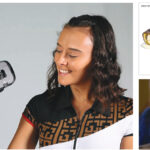Multifocal lenses, or progressive lenses as they are also called, are lenses developed for people who have reached around the age of 40 and experience a natural feeling of weakening near vision due to physiological changes.
The lenses are designed to allow clear vision at distance, near, and all areas in between without the need to change glasses.
Multifocal lenses are often divided into three zones:
The upper area of the lens – is the area used for distance, allowing the wearer to see distant objects, such as when driving or watching TV.
The middle area of the lens – is for intermediate distance vision and is responsible for activities such as working at a computer or reading characters and drawing.
The lower area of the lens is for close vision, reading books and newspapers, and also using a mobile phone.
It should be noted that due to structural constraints in lens manufacturing, the peripheral parts include areas that contain distortions and blurred vision, mainly in basic lenses. In advanced lenses, this problem is reduced and sometimes not noticeable at all.
The transition between the areas on the surface of the lens is not visible.
Multifocal glasses are an effective solution for people who require correction for multiple distances, allowing one single pair for all visual requirements.
There are different types of multifocal lenses of different quality and more or less advanced technologies.
What distinguishes the different types of lenses and why are there such large gaps in quality and price?
The different types of lenses differ in the internal design of the lens, technology, and features.
The basic progressive lens – has a polishing of the prescription only in the front part of the lens (the area farthest from the eye) and a gradual change of the prescription from the upper part of the lens to the lower part used for reading. These lenses provide clear vision but are limited in the field of vision. Sometimes people experience distortions in peripheral vision as a result of the structure of the lens, especially with high prescriptions, but not only. This lens is considered outdated today. Advanced progressive lens – allows for a more personalized fit (the lens is polished with both front and back polishing that is close to the eye, which allows for a better fit and a wider field of vision, especially in the peripheral areas. Usually adjusted to the client's prescription (high minus or plus prescription, cylinder, etc.) as well as to the chosen frame.
Custom progressive lenses – customized to the client based on their prescription, lifestyle and daily activities, eye movements and head position, and importance is also given to the time a person spends on various activities.
The technology is based on big data (collecting statistical data from thousands of people). This approach allows for a design that reduces distortions and increases the clear vision area, increasing comfort by increasing the clear vision area and therefore the ability to adapt.
Technologies are used to design lenses based on the client's visual age and daily activities.
The advantage is better adaptation to the user's lifestyle and focus on specific actions and a better overall experience.
Multifocal lens for people with poor vision
People with poor vision also sometimes need multifocal glasses.
Not in all cases can multifocal glasses be made for people with poor vision, for two reasons:
One – sometimes the prescription the patient needs is too high or has data that cannot be provided with a multifocal lens.
Second – sometimes it would not be right to give people with poor vision, who already have difficulty seeing, a lens that is divided into a number of relatively small areas. It would be right to give each action the maximum area possible.
But after a thorough examination and personal assessment of the patient's condition, multifocal glasses may be considered.
Especially in situations where the patient already has multifocal lenses and finds it difficult to give them up justifiably.
When visual acuity allows, a relatively higher than average reading supplement can be given, allowing the use of multifocals despite the eye problem, thus providing a solution to the reading ability that decreases with the eye disease.
It is also possible to add a 6-3% magnification to the lens of the glasses with the help of special polishing. Magnification in the glasses provides improved vision, and if it comes to driving, the ability to react will be faster, improving vision in general, improving reading ability. In addition, the glasses can be equipped with a special filter to increase contrast and thus improve the quality of vision.
Fitting multifocal glasses properly requires maximum precision of the prescription, precise measurements of the position of the glasses and the distance between the pupils, listening to the patient's needs, and proper consideration in choosing the type of lens from the available options.





